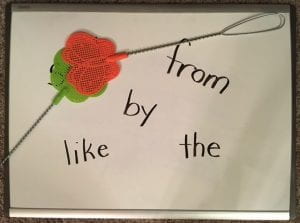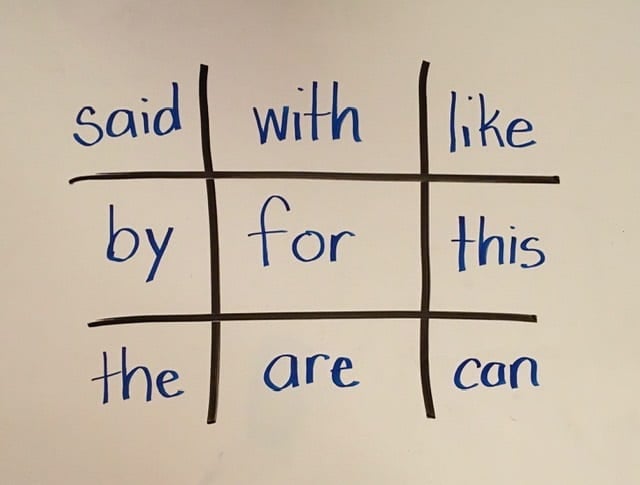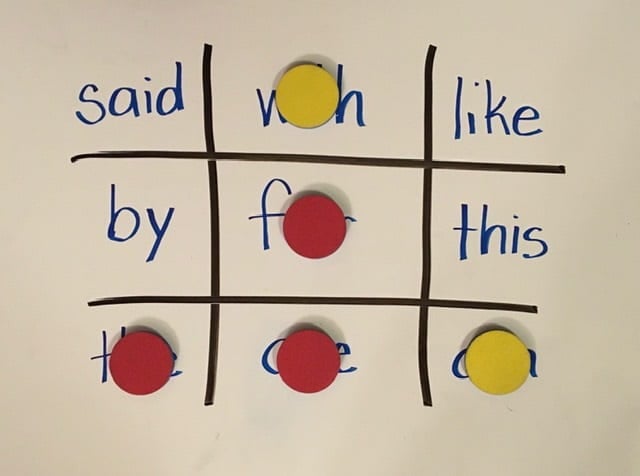by C. Elkins, OK Math and Reading Lady
This post contains some of my favorite sight word activities and resources to help your students practice those sight words and high frequency words. If you haven’t read part 1 (Sight word instructional tips), be sure to do that as it contains information about research based teaching strategies. These all focus on ways for the child to actually read / say the word and use in a sentence, not merely matching, copying, or building the word. Here goes!!
- Sight word tic-tac-toe:
- Played with partners or teacher vs. students
- Materials needed: tic-tac-toe template on a small whiteboard or on a laminated page
- Two-color counters so each student can mark their spot
- Select 9 sight words you would like to review. Have students write them in randomly in the 9 tic-tac-toe spaces
- Each player selects a word to read. If read correctly, they can put their counter on the space. You may also require students to use the word in a sentence.
- 3 in a row wins the game. Then play again!
- You may choose to give corrective feedback regarding missed words: Example: “No, this word is ________. You say it.”
- Sight word sentence cards:

from thisreadingmama.com
- Using the words in sentences (or phrases) helps students put the word into context.
- Try these sight word cards from a blogger I follow (www.thisreadingmama.com). If you subscribe to her blog, you will find these and dozens of other good reading resources for free. Check out: Sight Word Cards with Sentences (Link to free resources)
- I mentioned this in the last post, but a great research-based method for using these with individual students is to select no more than 10 words. Show the word. If it is known, put it in a separate pile. If it is unknown or the child is hesitant or guesses, tell the child the word, read the sentence so they can hear it in context, have the child say the word, then put the card 2-3 spaces back in the pile so they will see it again in a short amount of time. Repeat with other cards.
- Sight word teaching routine:
- Please take a look at this KG teacher’s routine for teaching and practicing sight words. It is called “Sight Word 60” because through this routine, students get a chance to hear and use the word 60 times during the week. Sight Word 60 by Greg Smedly-WarrenLook for videos for each day, plus center and celebration activities. This routine can also be followed in 1st and 2nd grade classes or small groups. Especially good for use with tutors, paraprofessionals, or volunteers!
- Sight word path game:
- This simple path game scenario is well-researched. You are likely to find several versions available. Here is mine (also pictured below): Reading Race Track for Sight Words CE In part 1 (last post), I linked one from another popular blogger (Playdough to Plato). Here is another editable one from Iowa Reading Research: Reading Race Track (editable).
- Teacher fills in the words being practiced (5-7 words repeated 4x each placed randomly).
- The track can be used by students for practice (they can roll a die, move to the space, pronounce the word, and perhaps use it in a sentence).
- The track can be used by teachers and students for timed practice after they have been introduced. A recording sheet is included with my version as well as the Iowa version.

Page 2 of Reading Race Track by C.E.
- Sight words in context:
- Of course students benefit from practicing sight words in context. In your guided reading group, allow students to use mini magnifying glasses (check the dollar stores) or those fancy finger nails that slip over a finger to locate sight words you call out. Example: “Find the word said on this page. Can you find it on another page? Read the sentence it is in to your partner.”
- My favorite way to practice sight words in context is through short, fun poetry. Here is a great resource (sorry, it’s not free) full of poems which target specific sight words. I’m sure there are others out there – let us know of ones you have found! Sight Words Poems for Shared Reading by Crystal McGinnis (TPT for $4.00)
- SWAT!
-
- Find some new flyswatters. If you are working with a small group, you just need 2.
- Lay out 4-8 sight words you are working on (table top or floor). You could also write them on the board. Teacher calls out a word.
- The object is for the students to locate and hold their swatter on the word you call out.
- The student who found it first will have their swatter under the second student’s swatter — proof of who found it first.
- This is also great for other vocabulary practice or math facts!!

Find the word “said”
-
- Memory / Concentration:
- Make 2 copies of each sight word on index size cards. You might limit to 8 cards for KG students and 12 cards for 1st or 2nd.
- Arrange the cards in a rectangular array.
- First player selects 2 cards to turn over and read. If they are a match, they can keep them.
- STRESS to students to just turn the cards over and leave them down — don’t pick them up. This is because the other students are trying to remember where these are located – and they need to be able to see them and their location. It’s a brain thing!!
Notice that in all of these methods, the students need to read and say the word (and perhaps use it in a sentence). Be sure your sight word activities reinforce these. Activities in which students just merely match, stamp, copy, write in different colors, recreate with letter tiles, etc. do very little to help them really know the word. Have FUN!!!
What other sight word activities have you tried that you’d like to share? Take care, friends!


